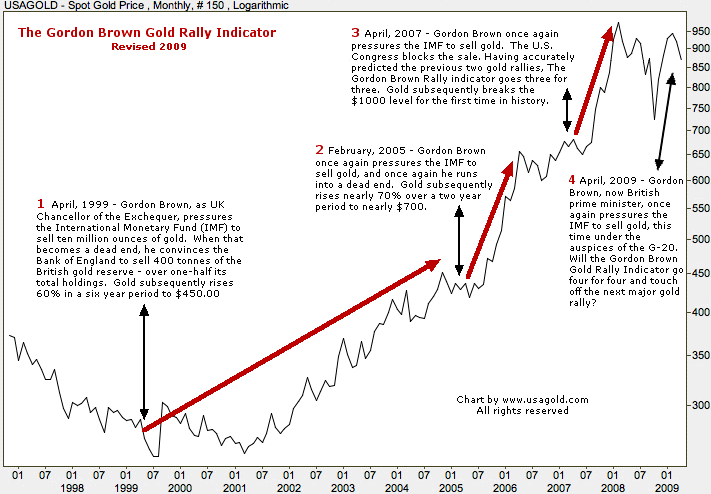The Gordon Brown Gold Rally Indicator Flashing a Buy Signal
Commodities / Gold & Silver 2009 Apr 20, 2009 - 12:30 PM GMT As illustrated above, British Prime Minister Gordon Brown's serial attempts to persuade the International Monetary Fund to sell gold have proven to be one of the more reliable indicators of an impending price spike. Over the past decade, Brown has begged, pleaded and otherwise cajoled the IMF no less than four times to sell from its 3217 tonne hoard. Each of the first three attempts were stymied for one reason or another (mostly having to do with reluctance on the part of the U.S. Congress) and each was the harbinger of a major price rally. Brown's fourth and latest attempt to pry metal out of the IMF came during the early April meeting of G-20 in London.
As illustrated above, British Prime Minister Gordon Brown's serial attempts to persuade the International Monetary Fund to sell gold have proven to be one of the more reliable indicators of an impending price spike. Over the past decade, Brown has begged, pleaded and otherwise cajoled the IMF no less than four times to sell from its 3217 tonne hoard. Each of the first three attempts were stymied for one reason or another (mostly having to do with reluctance on the part of the U.S. Congress) and each was the harbinger of a major price rally. Brown's fourth and latest attempt to pry metal out of the IMF came during the early April meeting of G-20 in London.

The accompanying chart was last published in April, 2007 just after Brown's third appeal to the IMF and just before the historic price run-up that took gold over the $1000 mark. His initial appeal in 1999 came just prior to the first leg of gold's present bull market which took gold from $280 to $450 -- a 60% gain. The second came just prior to the 2005-2007 price run-up which took gold from $425 to the $650 level -- a gain of more than 50%. The current plan, awaiting U.S. Congressional approval, is for the IMF to sell a 403 tonne tranche involved in credit repayments between 1999 and 2000.
This time around the prime minister's foray into the gold market has run into some unexpected turbulence. China and India, according to a Bloomberg report last week, has requested that the IMF sell the entirety of its reserve, that is, all 3217 tonnes. Given the dire circumstances within the present monetary order, it is not difficult to understand why. Growing official sector gold demand has been one of the more interesting side bars to the current economic crisis. China and India, it seems, have just upped the ante. If potential IMF sales bring to the surface a growing desire by central banks and nation states to acquire gold and in significant amounts, we may be in a whole new ball game -- one that could add to the already notable verticality of the last two legs of the bull market. The Gordon Brown Gold Rally Indicator might once again prove its reliability in 2009, but if so, it could be for reasons that carry much deeper implications for the gold market and world monetary order in the months to come.
The politics of gold
 Often lost in the debate about IMF sales is the fact that the founding states, which originally contributed the bulk of the IMF gold reserve, would be out this physical metal should it be liquidated. The IMF gold is not some amorphous, orphaned hoard lacking claims of ownership. It is in fact an important entry on the balance sheets of the nation states which contributed it, and those contributors include, among others, the United States and several of the larger European states. This leads to some interesting complications in the international politics of gold.
Often lost in the debate about IMF sales is the fact that the founding states, which originally contributed the bulk of the IMF gold reserve, would be out this physical metal should it be liquidated. The IMF gold is not some amorphous, orphaned hoard lacking claims of ownership. It is in fact an important entry on the balance sheets of the nation states which contributed it, and those contributors include, among others, the United States and several of the larger European states. This leads to some interesting complications in the international politics of gold.
If you would like to broaden your view of gold market news and analysis, please feel welcome to join our free NewsGroup to receive by e-mail periodic gold news alerts and USAGOLD Market Updates with relevant commentary like this one.
When you take into account that by IMF rules the contributing states still hold the right to restitution at the contributing price, which is currently around $52 per ounce, one wonders how much incentive truly exists for sales of ANY size let alone the reserve in its entirety as China and India have suggested. The European states, for example, might question why their portion of the IMF gold reserve should be utilized to satisfy the trade imbalance problems of the United States (which is what China and India are in fact suggesting) -- particularly at these prices and even if the sale is a comparatively modest 403 tonnes.
 Perhaps that is the rationale behind the IMF and Gordon Brown concentrating on the 403 tonne tranche involved in credit repayments in 1999-2000. The IMF claims that this gold is not subject to the restitution clause and thus not available to members. There was a time when such a rationale might go unchallenged, but these are unusual times and unusual circumstances. In the 1970s, under economic circumstances similar to today's, IMF members compromised on the restitution issue. Over 1500 tonnes of gold were earmarked for sale, but half went to members under the restitution clause and the other half was auctioned.
Perhaps that is the rationale behind the IMF and Gordon Brown concentrating on the 403 tonne tranche involved in credit repayments in 1999-2000. The IMF claims that this gold is not subject to the restitution clause and thus not available to members. There was a time when such a rationale might go unchallenged, but these are unusual times and unusual circumstances. In the 1970s, under economic circumstances similar to today's, IMF members compromised on the restitution issue. Over 1500 tonnes of gold were earmarked for sale, but half went to members under the restitution clause and the other half was auctioned.
If the gold standard is to be reinstituted, and the appeal by China and India has the taste and feel, at least in a de facto sense, of a return to using gold as a final means of payment, it will have to be applied fairly and universally. No state should curry favor or somehow nudge their way to the front of the line. In addition, as recently suggested in an article on the gold standard by the Financial Times' Gillian Tett, the price would have to be multiples the current price in order to truly deal with the problem of international dollar imbalances. In the end, all the talk about IMF gold sales might be the catalyst to discovering what really needs to be done to solve the festering monetary problem which has been loosed on the world economy by the present economic crisis.
Final Note: The link below will take you to much-needed question and answer session assembled by the International Monetary Fund on the subject of its gold sales. A study of this page and its subsidiary links will lead to a better understanding of the issue, i.e., what is and isn't possible under the present circumstances.
IMF - Gold Frequently Asked Questions
By Michael J. Kosares
Michael J. Kosares , founder and president
USAGOLD - Centennial Precious Metals, Denver
Michael Kosares has over 30 years experience in the gold business, and is the author of The ABCs of Gold Investing: How to Protect and Build Your Wealth with Gold, and numerous magazine and internet articles and essays. He is frequently interviewed in the financial press and is well-known for his on-going commentary on the gold market and its economic, political and financial underpinnings.
Disclaimer: Opinions expressed in commentary e do not constitute an offer to buy or sell, or the solicitation of an offer to buy or sell any precious metals product, nor should they be viewed in any way as investment advice or advice to buy, sell or hold. Centennial Precious Metals, Inc. recommends the purchase of physical precious metals for asset preservation purposes, not speculation. Utilization of these opinions for speculative purposes is neither suggested nor advised. Commentary is strictly for educational purposes, and as such USAGOLD - Centennial Precious Metals does not warrant or guarantee the accuracy, timeliness or completeness of the information found here.
Michael J. Kosares Archive |
© 2005-2022 http://www.MarketOracle.co.uk - The Market Oracle is a FREE Daily Financial Markets Analysis & Forecasting online publication.



